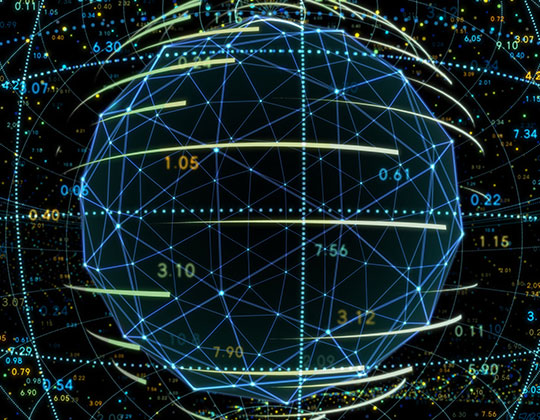
Secure communications in the future will require two things: space and quantum. Constellations spoke with Dr. Mark Adams of the STORM Lab at Auburn University, about the unique advantages of quantum key distribution over classical encryption, its progress, and the challenges for applying it in space.
Today’s sophisticated encryption works “perfectly fine with modern day computing and is hard to crack,” Adams said, but with quantum computing on the horizon, traditional encryption methods aren’t assured indefinitely.
As soon as quantum computers come online in the next five to 10 years, the algorithmic-type encryption of today’s computing will go to the wayside, as quantum computing can solve it very quickly,” said Adams.
Getting a Handle on Quantum
Although quantum principles can be a hard to grasp compared to classical computing. Adams provided the reminder that we interact with quantum mechanics every day in ways we don’t realize. Quantum’s “interesting properties” have been harnessed and applied to more traditional processing for everything from fluorescent lighting and LEDs to lasers and most of the micro-electronics technology used today.
“There's tremendous examples of how we've leveraged quantum phenomenon to progress from a technological standpoint,” said Adams.
Next up is applying these natural quantum properties to impending challenges such as security.
As Associate Professor of Electrical and Computer Engineering at Auburn University, where he established the STORM Lab (Sensors Transducers, Optics, RF, and MEMS), Adams is working on quantum key distribution (QKD), a type of quantum encryption to improve the security of communications.
Countering Quantum with Quantum
“We're taking advantage of the quantum properties of light in order to create a secure communications technique that a quantum computer can't really hack,” Adams said.
Quantum key distribution (QKD) uses the optical generation of photons to send a secure key, thereby using the quantum properties themselves to make it resilient against quantum intercepts.
Not only does QKD make it hard to hack quantum encryption, Adams explained, but it also makes it possible to detect eavesdroppers, adding to its allure for sensitive government and military communications.
“You can tell when someone's listening in on your conversation,” and conversely, he added, “you can imagine if you want to spy on someone else, you don't want them to know they’re being spied on.”
That is leading to a quest of sorts with government entities looking to find ways to do what's known as “post quantum.”

A Quantum Leap…to Space
Thus far, quantum is currently more developed for terrestrial applications, Adams said, with a number of companies introducing quantum key distribution for optical networks. That, however, requires users or networks to be connected by fiber optics, an impracticality in a world where cable can’t run everywhere.
“The best way to be able to make QKD more accessible, is to put it in space,” said Adams said. “If we have an operational system in space, then it's accessible anywhere on the planet.”
Adams’ team is using a protocol called BB84 established in 1984, so although quantum isn’t new, putting it into a small satellite is.
“A lot of engineering has to go into it. We're working on taking the technologies that have been developed and demonstrated in labs over the past 30 years suitable for a satellite in space,” he said. “From a technological perspective, we want to show that we can do the same thing you can do through a traditional fiber optic cable, and do it from a low orbit satellite to a ground station.”
The Quantum Race
Adams explained how the Chinese, with significant government investment, demonstrated QKD in a large 600-kilogram satellite in 2016, which showed they were further ahead in space-born technologies for quantum communication.
That caught the U.S. off guard, he says. “We're starting to really ramp up our investment in quantum technologies. We had been relying on the commercial industries to really push quantum computing, but for the other types of quantum, quantum communications, quantum sensing, those kind of things, we were kind of caught on a back foot by the Chinese when they put this up.”
Adams is looking to take it further, or rather, “trying to shrink it,” he said of secure quantum communications, which is no easy feat. His team’s efforts are focused on progressing QKD so it can be done on a 12-U CubeSat, which he described as about the size of a boot box. That entails reducing the SWaP – the size, weight and power – to put it on the cubesat, which presents distinct challenges.
In contrast to the high altitude 600 kg satellite the Chinese have, which represents a single test bed, Adams said “we would like to be able to do this across a constellation of satellites in low Earth orbit to produce global coverage.”
As a next step, he expects to demonstrate technology that shows the key components of QKD can be accomplished from a smallsat. Although the covid-19 pandemic has caused some delays, through a project funded through the University Nanosatellite Program and sponsored by the Air Force Research Laboratory, he anticipates a late 2024-early 2025 launch.
“And so, from a quantum optic standpoint, we've known how to do this from a laboratory for quite some time. It's a lot harder moving it from a laboratory to a spacecraft, moving it from a spacecraft to a smallsat.”
To hear more from Dr. Adams on the nature of quantum, its preparation for the extreme conditions of space, and next steps such as the move from optical to microwave communications for reliability, click here to listen to the full interview.
